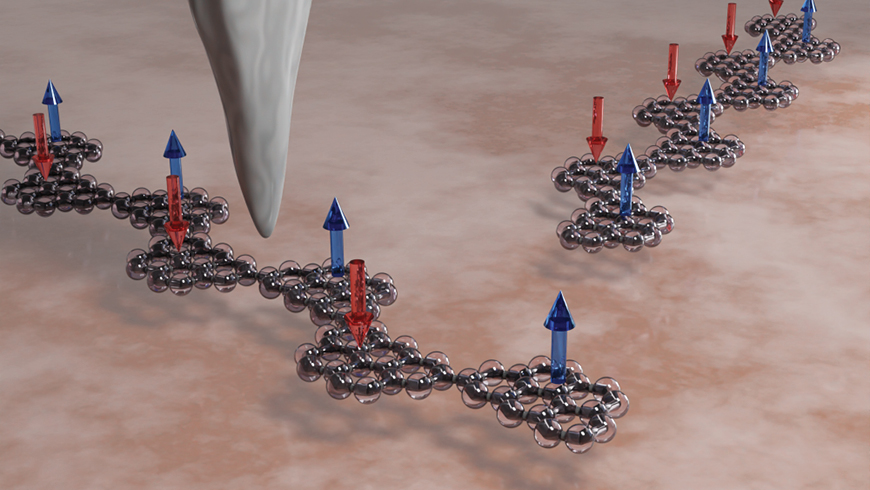We reach more than 65,000 registered users in Dec!! Register Now

Quantum spin model made from nanographene molecules
- April 04, 2025
- 4 Views
- 0 Likes
- 0 Comment
Empa researchers from the nanotech@surfaces laboratory have experimentally recreated another fundamental theoretical model from quantum physics, which goes back to the Nobel Prize laureate Werner Heisenberg. The basis for the successful experiment was a kind of “quantum Lego” made of tiny carbon molecules known as nanographenes. This synthetic bottom-up approach enables versatile experimental research into quantum technologies, which could one day help drive breakthroughs in the field. Molecular Lego bricks: For the homogeneous Heisenberg chain, the researchers used the nanographene molecule Olympicene, which consists of five carbon rings. Image: EmpaIn 2024, Empa researchers and their partners successfully for the first time realized a so-called one-dimensional alternating Heisenberg model with a synthetic material (link to article). This theoretical quantum-physical model, known for nearly a century, describes a linear chain of spins – a type of quantum magnetism. Now, the researchers led by Roman Fasel, head of Empa's nanotech@surfaces laboratory, have also been able to reconstruct the model's “sibling” in the lab.
Molecular Lego bricks: For the homogeneous Heisenberg chain, the researchers used the nanographene molecule Olympicene, which consists of five carbon rings. Image: EmpaIn 2024, Empa researchers and their partners successfully for the first time realized a so-called one-dimensional alternating Heisenberg model with a synthetic material (link to article). This theoretical quantum-physical model, known for nearly a century, describes a linear chain of spins – a type of quantum magnetism. Now, the researchers led by Roman Fasel, head of Empa's nanotech@surfaces laboratory, have also been able to reconstruct the model's “sibling” in the lab.
In the alternating model, spins are linked in a pattern of alternating strong and weak couplings. In the new model, however, the spins are evenly connected. This seemingly minor difference results in fundamentally different properties: The spins in the homogeneous chain are strongly entangled and exhibit long-range correlations, with no energy gap between the ground state and the excited states. In contrast, the alternating chain develops an energy gap, and its spins tend to form strong pairwise bonds, with correlations rapidly decreasing (exponentially). The researchers were able to precisely confirm these predictions of theoretical quantum physics in their nanographene spin chains. The corresponding findings have just been published in the latest edition of Nature Materials.
Both models were realized with nanographenes, tiny fragments of the two-dimensional carbon material graphene. By precisely controlling the shape of these fragments, the researchers can manipulate their (quantum) physical properties. The goal is to develop a material platform – a kind of “quantum Lego” – that allows various quantum models and effects to be experimentally studied.
Moving quantum technologies a (tiny) step closer to practical applications
The two Heisenberg experiments highlight this approach. For the alternating spin chain model, the researchers used so-called Clar's goblets as their starting material, hourglass-shaped nanographene molecules consisting of eleven carbon rings. For the homogeneous Heisenberg chain, they used a different nanographene: Olympicene, which consists of five rings and owes its name to its resemblance to the Olympic rings. Atomic precision: Microscopy images of the homogeneous Heisenberg chain made of Olympicene; top: atomic force microscopy, bottom: scanning tunneling microscopy. Image: Empa“We have now demonstrated for the second time that theoretical models of quantum physics can be realized with nanographenes, making their predictions experimentally testable,” says Fasel. Next, the researchers plan to use their nanographenes to create and investigate ferrimagnetic spin chains. In these chains, the magnetic moments align in an antiparallel manner but do not completely cancel out. Also of great interest are two-dimensional spin lattices, which exhibit a much greater variety of phases than spin chains, including topological states, quantum spin liquids, and exotic critical phenomena. This makes them particularly interesting, both for fundamental research and for practical applications.
Atomic precision: Microscopy images of the homogeneous Heisenberg chain made of Olympicene; top: atomic force microscopy, bottom: scanning tunneling microscopy. Image: Empa“We have now demonstrated for the second time that theoretical models of quantum physics can be realized with nanographenes, making their predictions experimentally testable,” says Fasel. Next, the researchers plan to use their nanographenes to create and investigate ferrimagnetic spin chains. In these chains, the magnetic moments align in an antiparallel manner but do not completely cancel out. Also of great interest are two-dimensional spin lattices, which exhibit a much greater variety of phases than spin chains, including topological states, quantum spin liquids, and exotic critical phenomena. This makes them particularly interesting, both for fundamental research and for practical applications.After all, recreating models from quantum physics textbooks is not just an academic exercise – it serves a practical purpose as well. Quantum technologies promise breakthroughs in communication, computing power, measurement technology and much more. However, quantum states are fragile, and their effects are difficult to grasp, making research into real-world applications particularly challenging. With their nanographene “quantum Lego”, Empa researchers hope to gain a deeper understanding of quantum effects and thus pave the way for usable quantum technologies.
List of Referenes
- Chenxiao Zhao, Lin Yang, João C. G. Henriques, Mar Ferri-Cortés, Gonçalo Catarina, Carlo A. Pignedoli, Ji Ma, Xinliang Feng, Pascal Ruffieux, Joaquín Fernández-Rossier, Roman Fasel. Spin excitations in nanographene-based antiferromagnetic spin-1/2 Heisenberg chains. Nature Materials, 2025; DOI: 10.1038/s41563-025-02166-1
Cite This Article as
No tags found for this post









